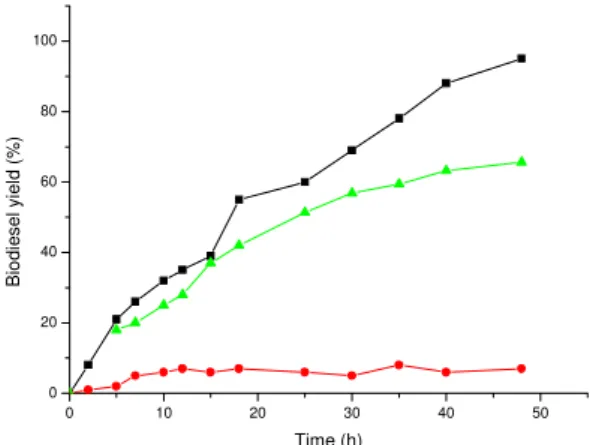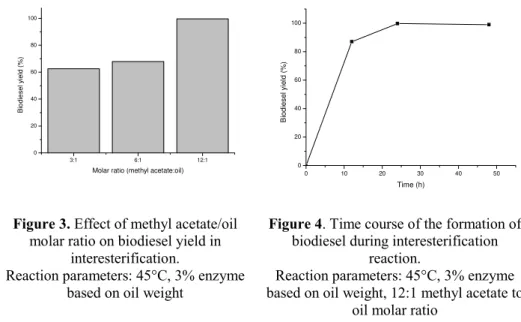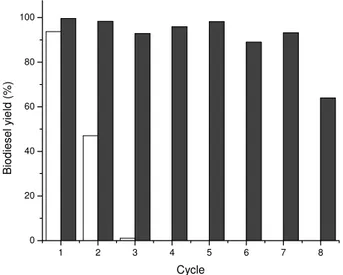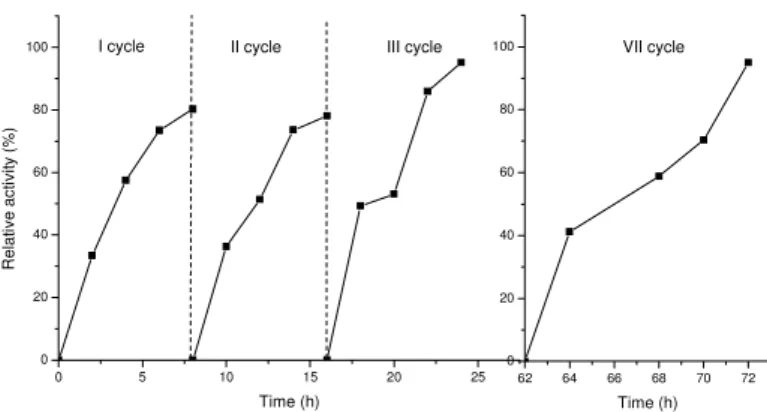LIPASE-CATALYZED BIODIESEL SYNTHESIS WITH DIFFERENT ACYL ACCEPTORS
Nevena D. Ognjanović, Svetlana V. Šaponjić, Dejan I. Bezbradica and Zorica D. Knežević
Biodiesel is an alternative fuel for diesel engine that is environmentally acceptable. Conventionally, biodiesel is produced by transesterification of triglycerides and short alcohols in the presence of an acid or an alkaline catalyst. There are several problems associated with this kind of production that can be resolved by using lipase as the biocatalyst. The aim of the present work was to investigate novel acyl acceptors for biodiesel production. 2-Propanol and n-butanol have a less negative effect on lipase stability, and they also improve low temperature properties of the fuel. However, excess alcohol leads to inactivation of the enzyme, and glycerol, a major byproduct, can block the immobilized enzyme, resulting in low enzymatic activity. This problem was solved by using methyl acetate as acyl acceptor. Triacetylglycerol is produced instead of glycerol, and it has no negative effect on the activity of the lipase.
KEYWORDS: Biodiesel, lipase, methanol, 2-propanol, n-butanol, methyl acetate
INTRODUCTION
Biodiesel (fatty acid methyl esters) is an alternative fuel for diesel engines that is environmentally acceptable. From an environmental point of view it shows clear advan-tages over conventional fuel: it comes from renewable sources, and hence does not con-tribute to new carbon dioxide emission, it is biodegradable, its combustion products have reduced levels of particulates, sulphur oxides, carbon oxides, nitrogen oxides, and the-refore, significantly reduces pollution (1, 2).Also, biodiesel is becoming increasingly im-portant because of diminishing petroleum reserves.
Conventionally, biodiesel is produced by transesterification of triglycerides and short chain alcohols, such as methanol, in the presence of an acid or an alkaline catalyst (3).
There are several problems associated with this kind of production. Removal of catalyst, excessive energy requirements, recovery of glycerol, undesirable side reactions are the major drawbacks for such chemical process. These problems can be overcome by using lipase as biocatalyst. The usage of lipases allows mild reaction conditions and easy reco-very of glycerol without purification or chemical waste production (4-6). Lipases ex-tracted from different sources have been successfully used in the production of biodiesel. Candida antarctica B lipase, immobilized on the acrylic resin, commercially known as Novozym 435, has been by far the most commonly used enzyme for the production of biodiesel (7, 8).
The enzymatic transesterification has been performed in a solvent and solvent-free media by various immobilized lipases (7, 9).However, enzymatic syntheses of biodiesel in organic solvents are not suitable from the application viewpoint because of toxicity, flammability of solvent, damaging effects on the environment and consequential requi-rement for its removal. Thus, to make the enzymatic process competitive, enzymatic sol-vent-free systems are being developed (10).
One of the main problems of implementing enzymes in biodiesel synthesis is low stability of the enzyme in the presence of the excess alcohol. The main obstacle in using methanol as the substrate, as several researches have reported, is that high methanol con-centration can lead to serious inactivation of the enzyme (11-13). In order to overcome these drawbacks a stepwise addition of methanol to the reaction medium has been pro-posed.However, operational stability of lipases in repeated cycles, in reactions with me-thanol, is not very high.
The aim of the present work was to investigate novel acyl acceptors in biodiesel pro-duction. Longer chain alcohols, 2-propanol and n-butanol have less negative effect on li-pase stability, and they also improve low temperature properties of the fuel (1, 11). How-ever, excess alcohol leads to inactivation of the enzyme, and glycerol, a major by pro-duct, can block the immobilized enzyme, resulting in low enzymatic activity (12). This problem was solved by using methyl acetate as acyl acceptor (13, 14).
MATERIALS AND METHODS
Materials
The commercial lipase from Candida antarctica B lipase, immobilized on the acrylic resin (Novozym 435), refined sunflower oil “Sunce” (Sunce a.d. Sombor, Serbia) and methanol, 2-propanol, n-butanol from Sigma (purity>99.8%, St. Louis, USA) were used as reactants in the enzymatic reaction. Methyl myristate was purchased from Fluka (Buchs, Switzerland) and used as an internal standard. All other chemicals were reagent-grade.
Enzymatic transesterification
equi-start of reaction; the second portion of methanol after 10 h, while the third portion was added after 25 h, according to previously obtained results. The reaction was carried out for 50 h. The mixture was agitated on a shaker at 150 rpm at 45°C for 50 hours.
Enzymatic interesterification
The reaction mixture with methyl acetate consisted of 5 g of oil, 3% of the enzyme based on oil weight and methyl acetate. The reaction conditions were optimized by car-rying out different sets of experiments with vacar-rying methyl acetate to oil molar ratio and reaction time. The reaction mixtures were agitated on a shaker at 150 rpm at 45°C.
Analysis of the samples
At the end of the reaction, the enzyme was separated out by filtration and the filtrate was washed with distilled water and hexane after transferring it to a separating funnel. The ester phase, diluted with hexane, was mixed with methyl myristate, which served as the internal standard. The methyl ester content in the reaction mixture was quantified by gas-chromatography using a GS Varian 3400, equipped with a fused silica capillary column (30m x 0.32mm x 0.1µm). The column temperature was held at 150°C for 2 mi-nutes, then heated to 190°C at 4°C/min, and held at that temperature for 3 mimi-nutes, hea-ted again to 250°C at 5°C/min, held at that temperature for 5 minutes, and then raised to 300°C at 4°C/min and maintained at this temperature for 2 min. The temperatures of the injector and detector were set at 320°C and 330°C, respectively. Methyl myristate served as the internal standard.
RESULTS AND DISCUSSION
0 10 20 30 40 50 0
20 40 60 80 100
B
io
d
ie
s
e
l yi
el
d (
%
)
Time (h)
Figure 1. Effects of alcohols on biodiesel production. Reaction parameters: 45°C, 3% enzyme on oil weight, 50h, 6:1 alcohol to oil ratio;() three-step addition of methanol,(z) one-step addition of methanol, (c) one-step addition of 2-propanol
50 100 150 200 250
0 20 40 60 80 100
B
iodi
esel
yiel
d
(%
)
Time (h)
Figure 2. Operational stability of lipase. Reaction parameters 45°C, 3% enzyme on oil weight, 50h, 6:1 alcohol to oil ratio, ()methanol, (z)2-propanol, (c)n-butanol
with methanol, production was not detectable even after the third cycle. Operational sta-bility of lipase in the transesterification reaction with 2-propanol and n-butanol was decreasing with time and after the third cycle, production of biodiesel was below 10%. This might be due to the inactivation effect caused by alcohol and the negative effect caused by byproduct glycerol adsorbed on the surface of the immobilized lipase. Bypro-duct glycerol is hydrophobic and insoluble in oil, so it is easily adsorbed onto the surface of the immobilized lipase, also exhibiting a negative effect on lipase activity and operati-onal stability (15).
In the second stage of our study, a novel acyl acceptor for biodiesel production, met-hyl acetate, has been used. The usage of metmet-hyl acetate eliminates the risk of deactivation of enzyme by glycerol, since no glycerol is produced in the reaction. Triacetin, a bypro-duct in the interesterification reaction has no negative effect on lipase activity and has a greater value than glycerol, which makes this kind of production very promising. Tria-cetin can be used as a fuel additive, as an antiknock agent which can reduce engine knocking in gasoline, and to improve cold and viscosity properties of biodiesel (16, 17). Since methyl acetate has no negative effect on enzyme stability a stepwise addition of methyl acetate was not needed.
3:1 6:1 12:1
0 20 40 60 80 100 Bio d ie s e l y ie ld ( % )
Molar ratio (methyl acetate:oil) 00 10 20 30 40 50
20 40 60 80 100 B iodi es el y ie ld (% ) Time (h)
Figure 3. Effect of methyl acetate/oil molar ratio on biodiesel yield in
interesterification.
Reaction parameters: 45°C, 3% enzyme based on oil weight
Figure 4. Time course of the formation of biodiesel during interesterification
reaction.
Reaction parameters: 45°C, 3% enzyme based on oil weight, 12:1 methyl acetate to
oil molar ratio
With these reaction parameters yield of 99.6% biodiesel was obtained. Similar results were obtained by Du et al. (17). They have obtained a yield of 92% of methyl esters for 12 h, however, the amount of enzyme in their study was 30% based on oil weight.
The reusability of immobilized lipase over repeated cycles was analyzed with methyl acetate. The operational stability of lipase was found to be constant over seven repeated cycles (200 h) without losing its activity (yield of 95. 65 ± 2. 01%), whereas in the eight cycle the yield was lower, 63. 96%. However, the activity of immobilized enzyme from C. antarctica decreased rapidly when methanol was used for biodiesel production, and after the third cycle it was below 5% (Fig. 5). Lipases exhibited poor activity during the repeated experiment, probably, as noted before, due to the inactivation effect caused by methanol and the negative effect caused by byproduct glycerol adsorbed on the surface of the immobilized lipase.
1 2 3 4 5 6 7 8
0 20 40 60 80 100
Biod
ies
e
l y
ie
ld (%
)
Cycle
Figure 5. Operational stability of lipase in batch system. Reaction parameters: 45°C, 3% of the enzyme based on oil weight, (■) methyl acetate (12:1 molar ratio) , (□) methanol
(6:1 molar ratio)
Figure 6. Operational stability in packed-bed reactor. Reaction parameters: 45°C, 3% of the enzyme based on oil weight, 12:1 methyl acetate to oil molar ratio
Operational stability of lipase was found to be constant over seven repeated cycles, for 74 h (Fig. 6). It can be observed that almost the same yield of biodiesel was obtained in the first, as in the seventh cycle. Results show that the enzyme did not lose its activity even in an excess of methyl acetate.
CONCLUSION
In this study, the use of different acyl acceptors in lipase-catalyzed biodiesel synthesis was studied. Short- chain alcohols such as 2-propanol and n-butanol have a less negative effect on lipase stability in comparison to traditionally used methanol, and they also im-prove low-temperature properties of the fuel. High yields can be achieved, but only with a stepwise addition of alcohol. Also, lipase exhibited poor activity during the repeated cycles. However, methyl acetate as novel acyl acceptor showed no negative effect on the enzymatic activity. The yield of 99.6% biodiesel was achieved at 45°C, 3% of lipase from Candida antarctica, 12:1 methyl acetate to oil molar ratio in a batch system. There was no loss detected in the enzymatic activity after seven repeated cycles. From the results it was concluded that methyl acetate could be a suitable acyl acceptor. The byproduct, triacetin, also has no negative effect on the activity of lipase and has a greater value than glycerol. Based on these results, a packed-bed reactor for interesterification with methyl acetate as acyl acceptor has been developed. Operational stability over repeated cycles showed that this process may be very promising for lipase-catalyzed large-scale production of biodiesel.
ACKNOWLEDGEMENT
This work was supported by the Ministry of Science and Technological Development of the Republic of Serbia (Project No TR 20064)
0 5 10 15 20 25
0 20 40 60 80 100
R
e
la
ti
v
e
a
c
ti
v
ity (
%
)
Time (h)
62 64 66 68 70 72 0
20 40 60 80 100
Time (h)
REFERENCES
1. Salis A., M. Pinna, M. Monduzzi, V. Solinas: Biodiesel production from triolein and short chain alcohols through biocatalysis. J. Biotech. 119 (2005) 291-299.
2. Al-Zuhair, S: Production of biodiesel: possibilities and challenges. Biofuels, Bioprod. and Bioref. 1 (2007) 57-66.
3. Shwab A.W., M.O. Bagby, B. Freedman: Preparation and properties of diesel fuels from vegetable oils. Fuel 66 (1987) 1372-1378.
4. Shimada, Y., Y. Wantanabe, A. Sugihara, Y. Tominaga: Enzymatic alcoholysis for biodiesel fuel production and application of the reaction to oil processing, J. Mol. Catal. B: Enzym. 17 (2002) 133-142.
5. Kose, O., M. Tuter, H.A. Aksoy: Immobilized Candida antarctica lipase-catalyzed alcoholysis of cotton seed oil in a solvent-free medium. Bioresour. Technol. 83 (2002) 125-129.
6. Harding, K.G., J.S. Dennis, H von Blottnitz, S.T.L. Harrison: A life-cycle comparison between inorganic and biological catalysis for the production of biodiesel. J. Clean. Prod. 13 (2007) 1368-1378.
7. Royon D., M. Daz, G. Ellenrieder, S. Locatelli : Enzymatic production of biodiesel from cotton seed oil using t-butanol as a solvent. Bioresour. Technol. 98 (2007) 648-653.
8. Watanabe Y., P.Pinsirodom, T. Nagao, T. Kobayashi, Y. Nishida, Y. Takagi, Y. Shi-mada: Production of FAME from acid oil model using immobilized Candida antarctica lipase. J. Am. Oil Chem. Soc. 82, 11 (2005) 825-831.
1. 9.Li L., W. Du, D. Liu, L. Wang, Z. Li : Lipase-catalyzed transesterification of rapeseed oils for biodiesel production with a novel organic solvent as the reaction me-dium. J. Mol. Catal. B: Enzym 43 (2006) 58-62.
9. Shah S., M.N. Gupta: Lipase catalyzed preparation of biodiesel from Jatropha oil in a solvent free system. Process Biochem. 42 (2007) 409-414.
10.Soumanou M. M., U.T. Bornscheuer : Improvement in lipase-catalyzed synthesis of fatty acid methyl esters from sunflower oil. Enzyme Microb. Technol. 33 (2003) 97-103.
11.Nie K., F. Xie, F. Wnag, T. Tan: Lipase catalyzed methanolysis to produce biodiesel: Optimization of the biodiesel production. J. Mol. Catal. B: Enzym 43 (2006) 142-147.
12.Watanabe Y., P. Pinsirodom, T. Nagao, A. Yamauchi, T. Kobayashi, Y. Nishida, Y. Takagi, Y. Shimada: Conversion of acid oil by-produced in vegetable oil refining to biodiesel fuel by immobilized Candida antarctica lipase. J. Mol. Catal. B: Enzym 44 (2007) 99-105.
13.Modi M. K., J.R.C. Reddy, B.V.S.K. Rao, R.B.N. Prasad: Lipase-mediate conversion of vegetable oils into biodiesel using ethyl acetate as acyl acceptor. Bioresour. Tech-nol. 98 (2007) 1260-1264.
Li-pase-catalyzed biodesel production from soybean oil deodorizer distillate with absor-bent present in tert-butanol system. J. Mol. Catal. B: Enzym 43 (2006) 29-32. 4. Du W., Y. Xu, D. Liu, J. Zeng: Comparative study on lipase-catalyzed transformation
of soybean oil for biodiesel production with different acyl acceptors. J. Mol. Catal. B: Enzym 30 (2004) 125-129.
ɉɊɂɆȿɇȺɇɈȼɂɏȺɐɂɅȺɄɐȿɉɌɈɊȺɍɉɊɈɐȿɋɍȿɇɁɂɆɋɄɂ
ɄȺɌȺɅɂɁɈȼȺɇȿɋɂɇɌȿɁȿȻɂɈȾɂɁȿɅȺ
. , . , .
.
y
-,
-ђ .
-: 2- n- .
, ,
, ,
.
.
-,
, , .
ђ , ,
-. ,
,
-.



